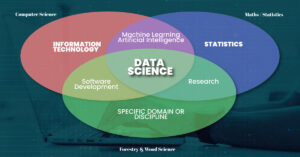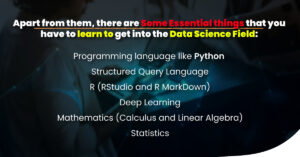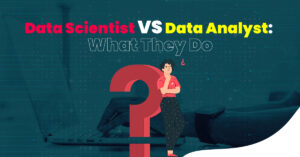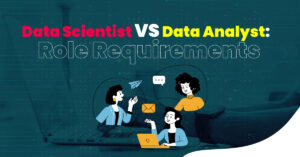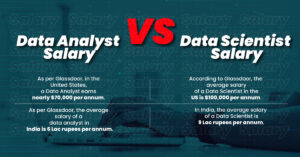Introduction to Data Analyst VS Data Scientist
“There were 5 exabytes of information created between the dawn of civilization through 2003, but that much information is now created every 2 days.” – Eric Schmidt, Ex-Google CEO
When we talk about data scientist vs data analyst, there is a blurred line of difference between them. In this blog, you are going to witness the importance and the difference between the two most wanted jobs of this era.
But first, understand their origin, i.e., Data Science.
Data Science can be understood as the science of data that requires computer science, statistics, machine learning, data visualization, and human computer interaction to clean, collect, interpret, and analyze the data to create different types of models that will be beneficial for the company.
Data science mainly provides 3 designations, i.e., data scientist, data analyst, and data engineer. A data scientist interprets and analyzes the data, and they are considered data wranglers who organize the data. A data analyst analyzes numeric data and delves deeper into it to discover meaningful insights from it. Last but not least, a data engineer is involved in data preparation. He creates, builds, tests, and maintains a complete data architecture.
For your better understanding, here is an explanation of terms and technologies used by data scientists :
- Data preparation: is the process of turning raw data into a more easily consumable format.
- Data visualization: the presentation of data in a pictorial or graphical format to facilitate analysis.
- Machine learning: a branch of artificial intelligence based on mathematical algorithms and automation.
- Deep learning is a subfield of machine learning research that employs data to model complicated concepts.
- Pattern recognition: data-recognition technology (often used interchangeably with machine learning).
- Text analytics: the process of analyzing unstructured data in order to derive important business insights.
Also read: TCS Data Analyst
Companies across the board have diverse approaches to identifying distinct job responsibilities. Job titles, in actuality, may not always accurately reflect one’s exact job responsibilities. There are various positions in the sector where perspectives regarding duties and abilities disagree, causing a lot of uncertainty.
Now let’s hop on to the main topic, Data Scientist vs Data Analyst.
Data Analyst and Data Scientist are two famous examples where many people appear to feel that a data scientist is simply an overly inflated title for a data analyst.
Data science, dubbed as “sexiest career of the twenty-first century“ has emerged as one of the most in-demand professions in recent years, attracting the kind of attention that is generally reserved for superstars. To recruit analytical talent, companies throughout the world offer attractive pay, status, and the ability to wield power. Behind the excitement is the increasing relevance of digital data, which is currently reshaping the way we live and work.
It’s no surprise that more and more people desire to work in this new area. However, before diving headfirst into data science and analytics, hopefuls should educate themselves on the many paths accessible. Prior to submitting job applications, interested applicants are recommended to begin their journey by identifying entrance points and prerequisites, learning more about how the many data subfields differ from one another, and refining their CV.
Following this line of reasoning, one question inevitably emerges. Data Scientist VS Data Analyst? Which one is better? After all, it appears that both professions are entrusted with deriving economic value from data. The logically astute reader may already be aware that having similarities does not guarantee interchangeability.
Both might complement each other as they work together to achieve a similar objective. Many natural phenomena have similarities in some regions but diverge dramatically in others.
The goal of this essay is to discover an answer to the different question. Not only from a theoretical standpoint, but also from the perspective of a seasoned professional who has witnessed how data teams work in the real world. This is due to the fact that job names and their fancy evocations are one thing, but the reality of day-to-day workload is quite another.
Also Read: IBM Data Engineer
Data Scientist VS Data Analyst: What They Do
Data analysts comb through data and generate reports and visuals to illustrate what insights the data conceals. The data analyst function is filled when someone uses charts to help individuals throughout the firm comprehend particular inquiries. In some aspects, they are similar to young data scientists or the initial step toward a data science position.
While, a data scientist’s primary responsibility is to gather and analyze data, derive meaningful insights, and share those findings with their firm.
A data scientist, according to “Doing Data Science” a book based on Columbia University’s Introduction to Data Science class, “spends a lot of time on the process of gathering, cleaning, and munging data, because data is never clean.”
According to the book, after the data is cleaned, “an important aspect is exploratory data analysis, which combines visualization with data sense.” Look for patterns, create models, and write algorithms, some to better understand product usage and the general health of the product, and others to serve as prototypes that will eventually be baked into the product.
Create experiments and play an important role in data-driven decision making. Communicate with team members, engineers, and upper management.
A data scientist must not only know how to gather and clean data, but also how to construct algorithms, detect trends, conduct experiments, and discuss data results with team members in an easily consumable style.
Also Read: Amazon Data Scientist Interview Process
Data Scientist VS Data Analyst: Role Requirements
What Are the Requirements for a Data Analyst?
An undergraduate STEM (science, technology, engineering, or math) degree is typically required for a data analyst job description. An advanced degree is desirable but not essential. The applicant must, however, be proficient in math, science, programming, databases, modeling, and predictive analytics.
Most important requirements:
- A degree in mathematics, statistics, or business with an emphasis on analytics
- Working knowledge of langu
ages such as SQL/CQL, R, and Python - A great blend of analytical abilities, intellectual curiosity, and journalistic expertise
- A strong grasp of data mining techniques, new technologies (MapReduce, Spark, large-scale data frameworks, machine learning, neural networks), and a proactive approach with the capacity to handle numerous objectives at the same time are required.
- Knowledge of agile development approach
- Excel and Office skills are exceptional.
- Excellent written and oral communication abilities
What Are the Role Requirements for a Data Scientist?
It should come as no surprise that becoming a data scientist necessitates a high level of education. We claimed that the majority of data scientists hold advanced degrees; in fact, over 90% do!
According to the industry portal KDnuggets, 88 percent of data scientists have a master’s degree and 46 percent have a Ph.D. The most prevalent degrees are in mathematics and statistics (32%), computer science (19%), and engineering (13%). (16 percent).
Glassdoor suggests the following credentials for a data scientist:
- Master’s or Ph.D. in statistics, mathematics, or computer science Knowledge of statistical computer languages such as R, Python, SQL, and others
- Extensive knowledge of statistical and data mining techniques such as generalized linear models/regression, random forest, boosting, trees, text mining, and social network analysis.
- Working knowledge of and experience with data structures
- Understanding of machine learning techniques including clustering, decision tree learning, and artificial neural networks
- Advanced statistical procedures and ideas, such as regression, distribution characteristics, and statistical tests, are required.
- 5-7 years of expertise handling data sets and developing statistical models is required.
- Experience with online services such as Redshift, S3, Spark, DigitalOcean, and others.
- Data analysis experience from third-party sources such as Google Analytics, Site Catalyst, Coremetrics, AdWords, Crimson Hexagon, Facebook Insights, and others.
- Knowledge of distributed data/computing tools such as Map/Reduce, Hadoop, Hive, Spark, Gurobi, MySQL, and others.
- Experience visualizing and presenting data to stakeholders using tools such as Periscope, Business Objects, D3, ggplot, and others.
A data scientist must be comfortable communicating their results to corporate stakeholders in addition to knowing data. Finding someone proficient in mathematics and coding who is also capable of presenting and explaining their findings in layman’s terms is difficult, which is why the title “data scientist” is so profitable.
Read Also: How to become data scientist at Google
Data Scientist VS Data Analyst: Responsibilities
What Are a Data Analyst’s Responsibilities?
The duties of a data analyst vary based on the business, but all need data analysis and interpretation. Examine job posts on Glassdoor to get a better idea of what else a data analyst does. As you can see, they place a greater emphasis on data science roles than on programming abilities.
Most of them, at their heart, include:
- Conduct consumer data analysis and research.
- Work with customer-centric algorithm models and customize them as needed.
- Extrapolate useful information from big datasets
- Conduct recurrent and ad hoc quantitative analysis to aid in day-to-day decision making.
- Assist with reporting and analytics, such as KPIs, financial reports, and the creation and improvement of dashboards.
- Assist in the transformation of data into visuals, measurements, and goals.
- To extract data from the data warehouse, write SQL queries.
What Are the Responsibilities of a Data Scientist?
A data scientist is defined as someone who understands more programming than a statistician and more statistics than a software engineer. A data scientist will be able to complete data science projects from start to finish. They can store and clean enormous volumes of data, study data sets for insights, construct prediction models, and tell a story based on the results. Many data scientists began their careers as data analysts before becoming data scientists.
According to Glassdoor, a data scientist should have the following responsibilities:
- Data mining and analysis from company databases to drive product development, marketing approaches, and business strategies optimization and improvement
- Predictive modelling may be used to improve and enhance customer experiences, revenue generation, ad targeting, and other areas.
- Create your own data models and algorithms.
- Create methods and tools for tracking and analyzing model performance and data accuracy.
- Examine the efficacy and precision of new data sources and data collection procedures.
- Create an A/B testing framework for the firm and test model quality.
- Coordination with various functional teams to deploy models and monitor results
Data Scientist VS Data Analyst Salary
Data professionals, like other in-demand vocations, make excellent pay. Corporations are recruiting fresh and knowledgeable personnel by offering competitive pay, enhanced benefits, and a favorable work-life balance. All of these positions demand at least a bachelor’s degree, which also comes with a better salary.
Salary of a Data Analyst
The BLS reports that data analyst wages vary widely depending on characteristics such as education, demonstrated skill set, and job experience. A beginner data analyst may earn $48,050 to $63,070 per year, while a more seasoned analyst may earn $86,200 per year. Other factors, such as industry and geographic area, might also have an influence on compensation.
Salary of a Data Scientist
Because of their extensive education, data scientists get paid more according to the BLS. Salary ranges for entry-level data scientists range from $52,950 to $71,790, with a median annual income of $103,930 for more experienced data
scientists. Of course, these figures will differ based on the position’s location, a candidate’s level of expertise, and the sector.
Final Words – Data Scientist vs Data Analyst
Data scientist vs data analyst may sound similar, but there is a great line of difference between these two. Data Scientist VS Data Analyst, either way, you will make sense of massive data sets, articulate trends and patterns, and participate in high-level decision-making in a corporate or government organization.
When picking between a data analytics and a data science profession, consider your career objectives, hobbies, and how much time you want to devote to further education and advanced training. Begin your adventure as a data analyst or data scientist with our range of programs: PG Program In Data Analytics, Advanced Post Graduate Program In Data Analytics, PG Program in Data Science, Machine Learning & Neural Networks, Applied Data Science With Python.
Frequently Asked Questions
Data scientist VS Data analyst: Which is more effective?
A Data Analyst position is better suited for people looking to begin a career in analytics. A Data Scientist position is advised for people who desire to construct sophisticated machine learning models and apply deep learning techniques to aid in the performance of human activities.
Data Scientists VS Data Analysts: Who makes more money?
It should come as no surprise that data scientists make much more than data analysts. The typical compensation of a data analyst varies depending on the type of data analyst – financial analysts, market research analysts, operations analysts, and so on.
Is it possible for a data scientist to become a data analyst?
Unfortunately, there are no specific skill sets that differentiate between the roles of a “Data Scientist” and a “Data Analyst.” In fact, many firms define each of these responsibilities differently, and there is a lot of gray space between the two job titles.
Data Scientist VS Data Analyst: What is more difficult to become?
Though certain tools and tasks are comparable, there is a significant distinction between the two job categories in data science. Both careers are excellent, and while becoming a data analyst is easier, the starting salary of a data scientist is greater.
Is coding required for the Data Analyst position?
Yes, Data Analysts must be able to code in order to modify and alter data. They are not, however, necessary to have extensive coding abilities.
What talents do Data Analysts and Data Scientists have in common?
Programming is used by both Data Analysts and Data Scientists to clean, manipulate, and analyze data. They also develop company reports using BI technologies like Excel and Tableau. Aside from this, Data Analysts and Data Scientists are experts in data manipulation and visualization.



